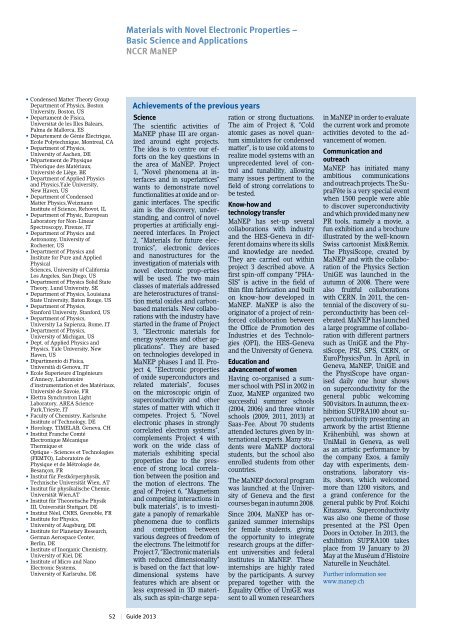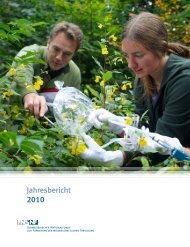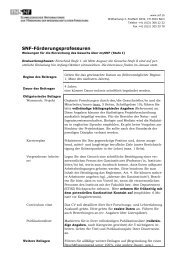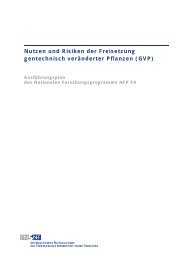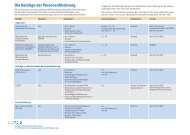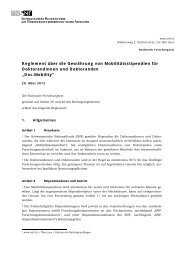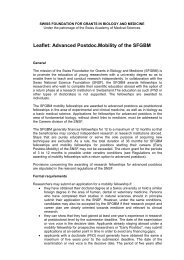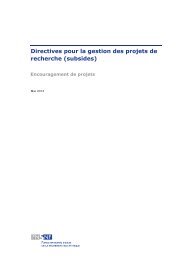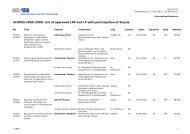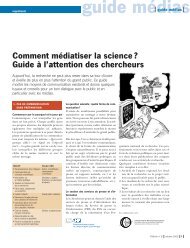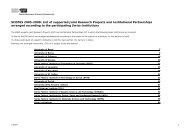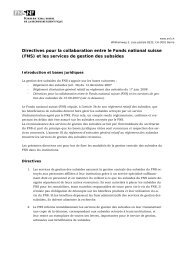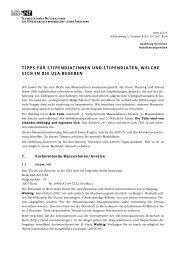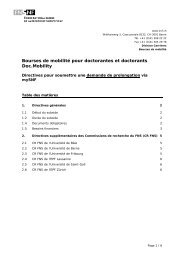NCCR Guide 2013 - Schweizerischer Nationalfonds (SNF)
NCCR Guide 2013 - Schweizerischer Nationalfonds (SNF)
NCCR Guide 2013 - Schweizerischer Nationalfonds (SNF)
You also want an ePaper? Increase the reach of your titles
YUMPU automatically turns print PDFs into web optimized ePapers that Google loves.
Materials with Novel Electronic Properties –<br />
Basic Science and Applications<br />
<strong>NCCR</strong> MaNEP<br />
• Condensed Matter Theory Group<br />
Department of Physics, Boston<br />
University, Boston, US<br />
• Departament de Fisica,<br />
Universitat de les Illes Balears,<br />
Palma de Mallorca, ES<br />
• Département de Génie Électrique,<br />
Ecole Polytechnique, Montreal, CA<br />
• Department of Physics,<br />
University of Aachen, DE<br />
• Département de Physique<br />
Thèorique des Matériaux,<br />
Université de Liège, BE<br />
• Department of Applied Physics<br />
and Physics,Yale University,<br />
New Haven, US<br />
• Department of Condensed<br />
Matter Physics,Weizmann<br />
Institute of Science, Rehovot, IL<br />
• Department of Physic, European<br />
Laboratory for Non-Linear<br />
Spectroscopy, Firenze, IT<br />
• Department of Physics and<br />
Astronomy, University of<br />
Rochester, US<br />
• Department of Physics and<br />
Institute for Pure and Applied<br />
Physical<br />
Sciences, University of California<br />
Los Angeles, San Diego, US<br />
• Department of Physics Solid State<br />
Theory, Lund University, SE<br />
• Department of Physics, Louisiana<br />
State University, Baton Rouge, US<br />
• Department of Physics,<br />
Stanford University, Stanford, US<br />
• Department of Physics,<br />
University La Sapienza, Rome, IT<br />
• Department of Physics,<br />
University of Michigan, US<br />
• Dept. of Applied Physics and<br />
Physics, Yale University, New<br />
Haven, US<br />
• Dipartimento di Fisica,<br />
Università di Genova, IT<br />
• Ecole Superieure d’Ingénieurs<br />
d’Annecy, Laboratoire<br />
d’instrumentation et des Matériaux,<br />
Université de Savoie, FR<br />
• Elettra Synchrotron Light<br />
Laboratory, AREA Science<br />
Park,Trieste, IT<br />
• Faculty of Chemistry, Karlsruhe<br />
Institute of Technology, DE<br />
• Horology, TIMELAB, Geneva, CH<br />
• Institut Franche Comté<br />
Electronique Mécanique<br />
Thermique et<br />
Optique - Sciences et Technologies<br />
(FEMTO), Laboratoire de<br />
Physique et de Métrologie de,<br />
Besançon, FR<br />
• Institut für Festkörperphysik,<br />
Technische Universität Wien, AT<br />
• Institut für physikalische Chemie,<br />
Universität Wien,AT<br />
• Institut für Theoretische Physik<br />
III, Universität Stuttgart, DE<br />
• Institut Néel, CNRS, Grenoble, FR<br />
• Institute for Physics,<br />
University of Augsburg, DE<br />
• Institute for Planetary Research,<br />
German Aerospace Center,<br />
Berlin, DE<br />
• Institute of Inorganic Chemistry,<br />
University of Kiel, DE<br />
• Institute of Micro and Nano<br />
Electronic Systems,<br />
University of Karlsruhe, DE<br />
Achievements of the previous years<br />
Science<br />
The scientific activities of<br />
MaNEP phase III are organized<br />
around eight projects.<br />
The idea is to centre our efforts<br />
on the key questions in<br />
the area of MaNEP. Project<br />
1, “Novel phenomena at interfaces<br />
and in superlattices”<br />
wants to demonstrate novel<br />
functionalities at oxide and organic<br />
interfaces. The specific<br />
aim is the discovery, understanding,<br />
and control of novel<br />
properties at artificially engineered<br />
interfaces. In Project<br />
2, “Materials for future electronics”,<br />
electronic devices<br />
and nanostructures for the<br />
investigation of materials with<br />
novel electronic prop-erties<br />
will be used. The two main<br />
classes of materials addressed<br />
are heterostructures of transition<br />
metal oxides and carbonbased<br />
materials. New collaborations<br />
with the industry have<br />
started in the frame of Project<br />
3, “Electronic materials for<br />
energy systems and other applications”.<br />
They are based<br />
on technologies developed in<br />
MaNEP phases I and II. Project<br />
4, “Electronic properties<br />
of oxide superconductors and<br />
related materials”, focuses<br />
on the microscopic origin of<br />
superconductivity and other<br />
states of matter with which it<br />
competes. Project 5, “Novel<br />
electronic phases in strongly<br />
correlated electron systems”,<br />
complements Project 4 with<br />
work on the wide class of<br />
materials exhibiting special<br />
properties due to the presence<br />
of strong local correlation<br />
between the position and<br />
the motion of electrons. The<br />
goal of Project 6, “Magnetism<br />
and competing interactions in<br />
bulk materials”, is to investigate<br />
a panoply of remarkable<br />
phenomena due to conflicts<br />
and competition between<br />
various degrees of freedom of<br />
the electrons. The leitmotif for<br />
Project 7, “Electronic materials<br />
with reduced dimensionality”<br />
is based on the fact that lowdimensional<br />
systems have<br />
features which are absent or<br />
less expressed in 3D materials,<br />
such as spin-charge separation<br />
or strong fluctuations.<br />
The aim of Project 8, “Cold<br />
atomic gases as novel quantum<br />
simulators for condensed<br />
matter”, is to use cold atoms to<br />
realize model systems with an<br />
unprecedented level of control<br />
and tunability, allowing<br />
many issues pertinent to the<br />
field of strong correlations to<br />
be tested.<br />
Know-how and<br />
technology transfer<br />
MaNEP has set-up several<br />
collaborations with industry<br />
and the HES-Geneva in different<br />
domains where its skills<br />
and knowledge are needed.<br />
They are carried out within<br />
project 3 described above. A<br />
first spin-off company “PHA-<br />
SIS” is active in the field of<br />
thin film fabrication and built<br />
on know-how developed in<br />
MaNEP. MaNEP is also the<br />
originator of a project of reinforced<br />
collaboration between<br />
the Office de Promotion des<br />
Industries et des Technologies<br />
(OPI), the HES-Geneva<br />
and the University of Geneva.<br />
Education and<br />
advancement of women<br />
Having co-organised a summer<br />
school with PSI in 2002 in<br />
Zuoz, MaNEP organized two<br />
successful summer schools<br />
(2004, 2006) and three winter<br />
schools (2009, 2011, <strong>2013</strong>) at<br />
Saas-Fee. About 70 students<br />
attended lectures given by international<br />
experts. Many students<br />
were MaNEP doctoral<br />
students, but the school also<br />
enrolled students from other<br />
countries.<br />
The MaNEP doctoral program<br />
was launched at the University<br />
of Geneva and the first<br />
courses began in autumn 2008.<br />
Since 2004, MaNEP has organized<br />
summer internships<br />
for female students, giving<br />
the opportunity to integrate<br />
research groups at the different<br />
universities and federal<br />
institutes in MaNEP. These<br />
internships are highly rated<br />
by the participants. A survey<br />
prepared together with the<br />
Equality Office of UniGE was<br />
sent to all women researchers<br />
in MaNEP in order to evaluate<br />
the current work and promote<br />
activities devoted to the advancement<br />
of women.<br />
Communication and<br />
outreach<br />
MaNEP has initiated many<br />
ambitious communications<br />
and outreach projects. The SupraFête<br />
is a very special event<br />
when 1500 people were able<br />
to discover superconductivity<br />
and which provided many new<br />
PR tools, namely a movie, a<br />
fun exhibition and a brochure<br />
illustrated by the well-known<br />
Swiss cartoonist Mix&Remix.<br />
The PhysiScope, created by<br />
MaNEP and with the collaboration<br />
of the Physics Section<br />
UniGE was launched in the<br />
autumn of 2008. There were<br />
also fruitful collaborations<br />
with CERN. In 2011, the centennial<br />
of the discovery of superconductivity<br />
has been celebrated.<br />
MaNEP has launched<br />
a large programme of collaboration<br />
with different partners<br />
such as UniGE and the PhysiScope,<br />
PSI, SPS, CERN, or<br />
EuroPhysicsFun. In April, in<br />
Geneva, MaNEP, UniGE and<br />
the PhysiScope have organised<br />
daily one hour shows<br />
on superconductivity for the<br />
general public welcoming<br />
500 visitors. In autumn, the exhibition<br />
SUPRA100 about superconductivity<br />
presenting an<br />
artwork by the artist Etienne<br />
Krähenbühl, was shown at<br />
UniMail in Geneva, as well<br />
as an artistic performance by<br />
the company Exos, a family<br />
day with experiments, demonstrations,<br />
laboratory visits,<br />
shows, which welcomed<br />
more than 1200 visitors, and<br />
a grand conference for the<br />
general public by Prof. Koichi<br />
Kitazawa. Superconductivity<br />
was also one theme of those<br />
presented at the PSI Open<br />
Doors in October. In <strong>2013</strong>, the<br />
exhibition SUPRA100 takes<br />
place from 19 January to 20<br />
May at the Muséum d’Histoire<br />
Naturelle in Neuchâtel.<br />
Further information see<br />
www.manep.ch<br />
52 | <strong>Guide</strong> <strong>2013</strong>


